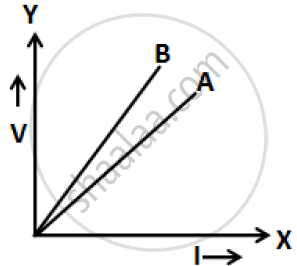Advertisements
Advertisements
प्रश्न
2Ω resistor A, 1Ω resistor B and 4Ω resistor C are connected in parallel. The combination is connected across a 2V battery of negligible resistance. Draw the diagram of the arrangement and calculate:
(i) The current in each resistor A and C,
(ii) The current through battery.
उत्तर
The diagram of the arrangement is shown in given figure.

(i) The current in resistor A is I1 = `"V"/"R"_1 = 2/2 = 1.0`A
The current in resistor B is I2 = `"V"/"R"_2 = 2/1 = 2.0`A
The current in resistor B is I3 = `"V"/"R"_3 = 2/4 = 0.5`A
(ii) The current through battery
I = I1 + I2 + I3
I = 1.0 + 2.0 + 0.5
= 3.5 Ampere.
APPEARS IN
संबंधित प्रश्न
The V-I graph for a series combination and for a parallel combination of two resistors is shown in the figure below. Which of the two A or B. represents the parallel combination? Give reasons for your answer.

Find the equivalent resistance between points A and B

(i) Two sets A and B, of three bulbs each, are glowing in two separate rooms. When one of the bulbs in set A is fused, the other two bulbs also cease to glow. But in set B, when one bulb fuses, the other two bulbs continue to glow. Explain why this phenomenon occurs.
(ii) Why do we prefer arrangements of Set B for house circuiting?
A p.d. of 4 V is applied to two resistors of 6 Ω and 2 Ω connected in series. Calculate:
(a) the combined resistance
(b) the current flowing
(c) the p.d. across the 6 Ω resistor
What is (a) highest, and (b)Ω lowest, resistance which can be obtained by combining four resistors having the following resistances?
4 Ω, 8 Ω, 12 Ω, 24 Ω
In the circuit shown below, calculate the equivalent resistance between the points (i) A and B, (ii) C and D.
Six equal resistors of 1 ohm each are connected to form the sides of a hexagon ABCDEF. Calculate the resistance offered by the combination if the current enters at A and leaves it at D.
With the help of a circuit diagram derive the formula for the resultant resistance of three resistances connected:
- in series and
- in parallel
The resistance of the hot filament of the bulb is about 10 times the cold resistance. What will be the resistance of 100 W-220 V lamps, when not in use?
